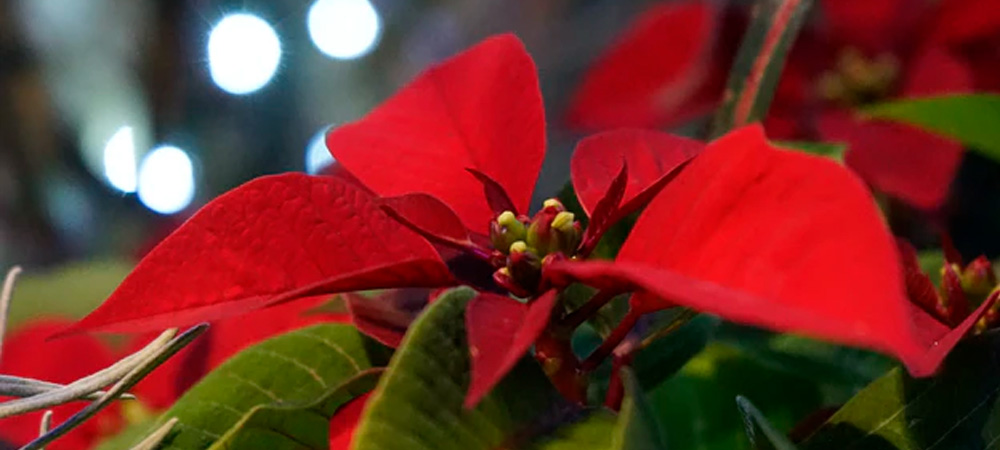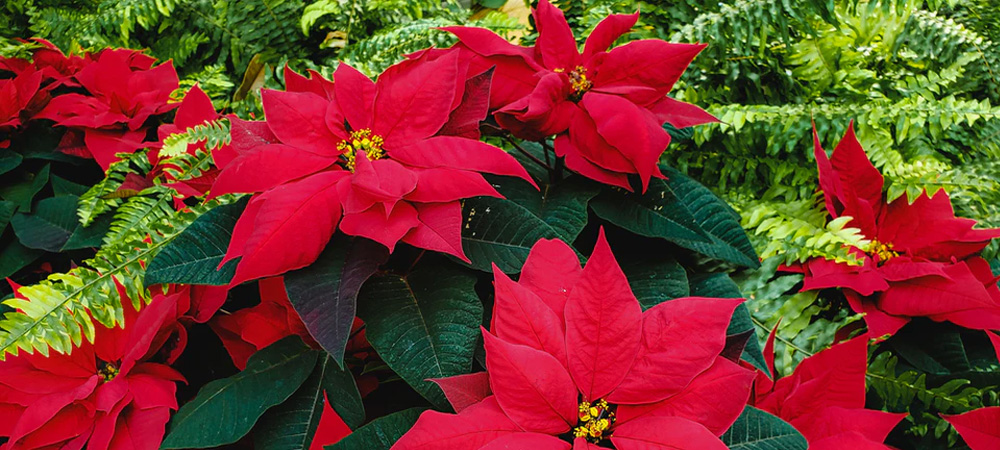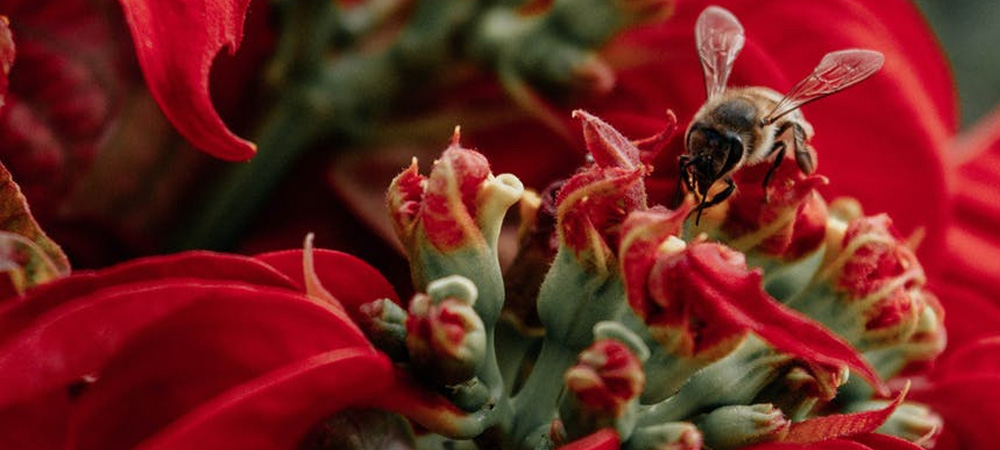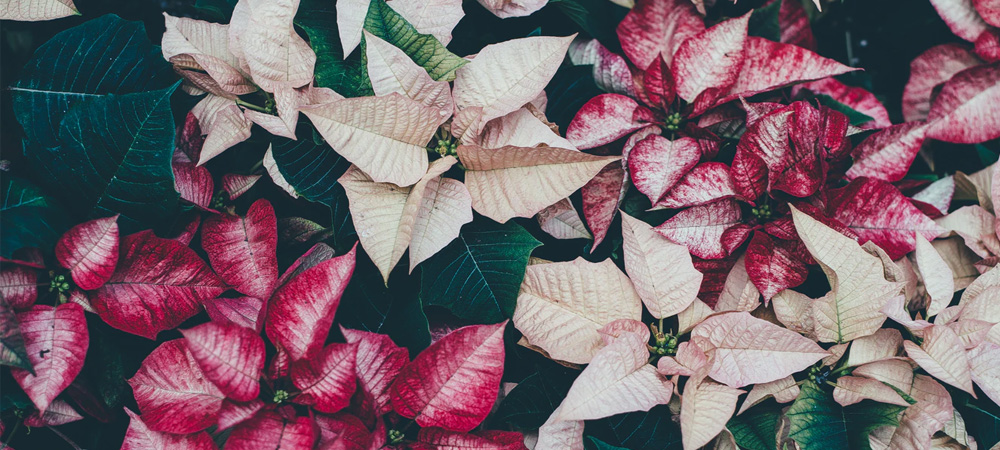How to Grow Poinsettias in a Greenhouse

Poinsettia plants (Euphorbia pulcherrima) are a beautiful vivid red adding a wonderful splash of colour to your greenhouse and your home in the winter months. Poinsettias are very popular to buy and give as gifts over the holidays. If you have a greenhouse, they can be the perfect thing to grow in the winter. Poinsettias require some work, specific strategies, and careful lighting but the extra effort will be well worth it when you end up with beautiful, healthy poinsettias to display in your home or give to your loved ones. Here are the steps to follow to ensure a successful December blooming.
Need a new greenhouse to plant your pointsettias? Browse our range online here.
Here are the Steps to Growing Your Poinsettia
1. Prepare Your Pot
Begin this process in the spring or summer. Start by preparing your well-draining container. You will fill the container with potting mix leaving a bit of room to mix in some organic matter. Use a hand trowel to add the organic matter (like peat moss). Adding the organic matter to the potting mix is an important step because it provides nutrients and allows the plant to absorb more water.
2. Plant the Poinsettia
Carefully plant your immature poinsettia plant into the container during the spring or summer. Ensure the root system is completely covered with the potting mix using a hand trowel. If you are growing your poinsettias from a cutting, ensure that the root system is already strong.
3. Watering
Poinsettias need a lot of water and so the soil should not be allowed to dry out completely. Use a watering can to water and watch to see that some of the water begins to leak through the container’s drainage holes. Check the soil daily for dryness. If the leaves look dry during the first week, you can also spray a fine mist on them to stop them from wilting.
Related reading: Greenhouse Buyers Guide

4. Sunlight
For best results, poinsettias should receive full sunlight until well into September. Placing your poinsettias near a south-facing wall in your greenhouse should do the trick.
5. Cover at Night
As soon as the weather begins to cool and there is a danger of night-time frost make sure you cover the poinsettia with a cardboard box for 14 hours each night. Typically, you will begin to cover them at night as soon as October hits. Keep the box away from the leaves of your poinsettias.
Shop greenhouse shading and insulation here.
6. Heating
It is important to keep your plants warm enough at night, so they don’t get frosty damage. Set the greenhouse temperature between 60- and 70-degrees Fahrenheit. Having the correct amount of light and the right temperature with help the plant flower and create the vibrant red colour poinsettias are known for.
Browse our greenhouse heaters here.
Finishing Touches
For the next ten weeks, your plants will need to be covered at night so your beautiful plants will be ready to proudly display at Christmas time.
Great work! Now it is time to show off your poinsettia plants! Display them inside or on a covered patio. The flowers will remain bright red and beautiful for several weeks, right through your Christmas holidays!
Read next: How to start an allotment for beginners

Common Issues When Growing Poinsettias
There are several mistakes growers can easily make when producing a crop of poinsettias. This article will home in on ten of the more common and detrimental mistakes. These errors can result in devastating losses, even the complete destruction of your crops. The production mistakes discussed in this article are presented in the sequence of the crop cycle.
1. Wilting Leaves from Lack of Early Moisture
During the first three or four days, poinsettia cuttings are extremely sensitive to wilting. If you allow your cuttings to wilt early, you will see leaf drop and less success with your plants. During the early days keep propagation mist levels high and light levels low. These two simple and easy to remember strategies will help establish your cuttings. Other than the first few days I suggest as little mist as possible.
After about four days you can decrease the mist because the leaf stomata are closing and the stem ends are healing. In short and simple terms, less mist will be needed to keep your plants healthy.
Read next: The history of a greenhouse
2. Using Acid - Cons outweigh the Pros
Acidifying irrigation water can improve the pH of the water and help to establish your crops early. Phosphoric acid is a popular choice when it comes to acidifying irrigation water. This is because phosphoric acid is safer to handle than sulfuric or nitric acid. Unfortunately, phosphoric acid can strip the protective waxy layer off the surface of leaves. In my point of view, it is not worth it.
The plant really has only one strong form of defence and that is the cuticle on the surface of its leaves. If this is removed the plant is vulnerable to pathogens and sun damage. If phosphoric acid is added to the mist, you are stripping away the plant’s defences each time you apply the mist. This can be true of other wetting agents as well. Be cautious and never apply more than the suggested amount.
3. Over Watering/Misting
As I mentioned earlier, in the first few days of the propagation cycle it is important to mist heavily in order to avoid wilting - but in the later days of propagation (weeks two and three) it is equally important to mist very lightly. Reducing mist as the cuttings are beginning to root will allow for stronger roots. If you notice a large ball of callus without roots you can be sure the cuttings are being too heavily misted.

4. Fungus Gnats
Fungus gnat problems are a common nuisance and can begin in propagation and continue right into finishing. Fungus gnats are especially problematic for poinsettias because they feed aggressively on them. Often the disease will progress slowly and an unobservant grower may not notice fungus gnats until it is too late. Keep a close eye on your plants and if you notice anything unsightly, take action. Fungus gnats especially love callus tissue.
Pythium is a plant parasite that is extremely harmful to poinsettias, I would go so far as to say that pythium is one of the biggest problems facing poinsettia growers. There seems to be a strong correlation between fungus gnats and pythium. If you have fungus gnats feeding on callus it is likely your plants will die from pythium if you do nothing to control them. There are several methods for eliminating fungus gnats including biological and chemical choices. Always do whatever it takes to control this particular pest.
Read next: How to prepare ground for a new greenhouse
5. Pinching
Poinsettia pinching can make your plants stronger and encourage more flowers to grow. Paying close attention to how often and how much you pinch is important for poinsettia quality. There is a little more to it than simply counting leaves to achieve the desired number of bracts. If you are selling your plants, the bracts will need to be in the correct position to meet retailers’ finished specifications. Growth control, internode length and spacing are all important factors to consider.
The length of the stem between nodes is referred to as internodes. Keeping internode length short on poinsettia plants results in higher quality because the bract heights are more even. Pay attention to internode spacing as you pinch your poinsettia plants.
There are growth regulator sprays that can be used to balance out your plant’s internode spacing. Along with the spray, it is essential to control growth during propagation and reduce internode length through the pinching process. For the highest quality plants it is essential to pay attention to the internode length and timing of your pinching.
6. Control Environment after Pinching
After you have pinched back your poinsettias the new branches are being formed. This is the time you need to be especially concerned with temperature, light and humidity as your plants are even more prone to stress. If your plant is exposed to extremely high temperature, low light levels or low humidity levels the axillary shoots will be stunted at best. Keeping a close eye on all of these factors will ensure your plant grows normally after pinching back the bracts.
7. Proper Plant Spacing
Be aware that as your poinsettia plants grow they will need more space to spread out. Leaving your plants in a compact pot for too long will weaken the plant. Spacing your plants on time is difficult and requires close observation. Your crops are going to be competing for space so make sure they have enough. Leaving plants spaced pot-to-pot can also result in increased height. It is possible to use a pot technique to get smaller varieties of poinsettias to grow taller.
8. Fertiliser
Feeding your plants the same amount of fertiliser throughout all of their developmental stages can result in less healthy plants. This is because as they grow their rate of nutrient uptake changes.
At the beginning of their life cycle, shortly after poinsettias are planted and pinched their growth is rapid and they will require extra nutrients. After flowers begin to emerge your plants will need a lower fertility level. This low nutrient uptake drops even further as the days shorten in the winter months. This is the time when it is especially important to reduce the amount of fertiliser your plants are receiving because excess nutrients at the end of the crop cycle will result in a shorter life for your plants.
9. Pythium
As mentioned in mistake number four many growers have seen their poinsettia crops destroyed by Pythium. Pythium MUST be treated. Failure to do so will almost certainly lead to crop loss. Be careful when treating Pythium with metalaxyl drenches. There are several varieties of Pythium that are resistant to metalaxyl drenches
10. Choose the Correct Variety
Choosing the correct variety for product form and market date is one of the easiest ways to simplify poinsettia production. It is not a good idea to try to grow one type of poinsettia for all market date. Growers that produce an early-season variety of poinsettia and hold them until mid-December result in some very disappointed customers as their plants quickly die. Match the variety you grow to the market date to keep delivering fresh plants to the consumers.
Other Things to Consider
There are several other considerations that this article did not touch on, but the most common ones are mentioned above. I would be remiss if I didn’t mention the dangers of ignoring certain pests such as whiteflies, Botrytis and powdery mildew. Anything that is clearly harming your plants must be dealt with swiftly. Poinsettias are not easy to grow, but with significant practice and the elimination of a few common mistakes, poinsettia production can become a great source of revenue and joy.
Related Growing Guides:
 Author:
Author: